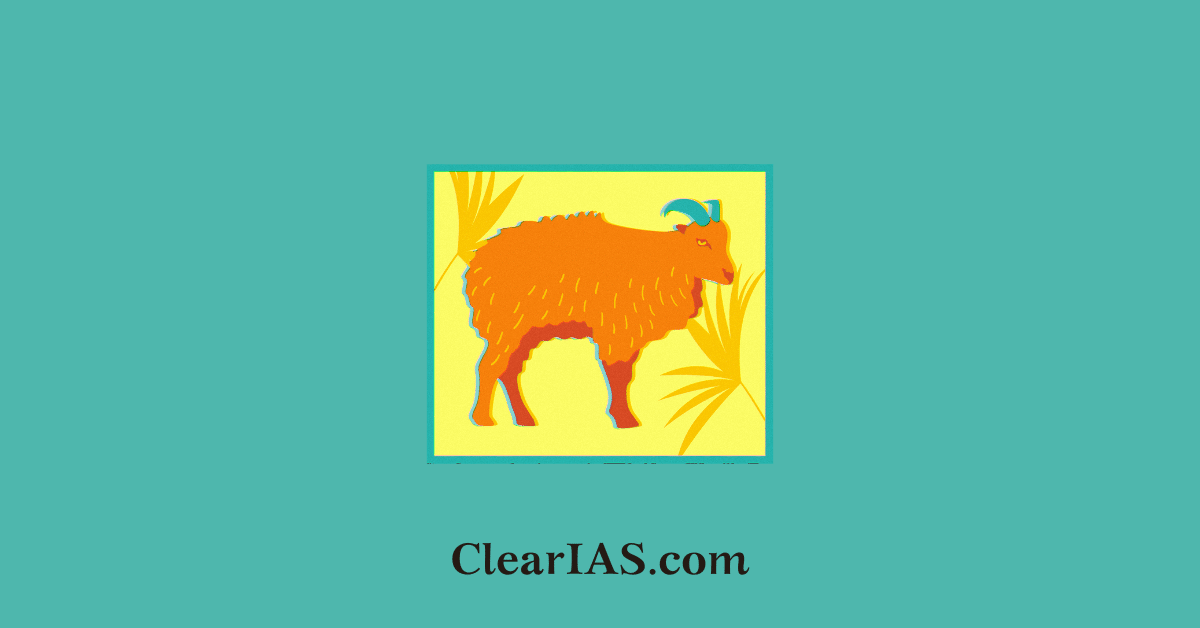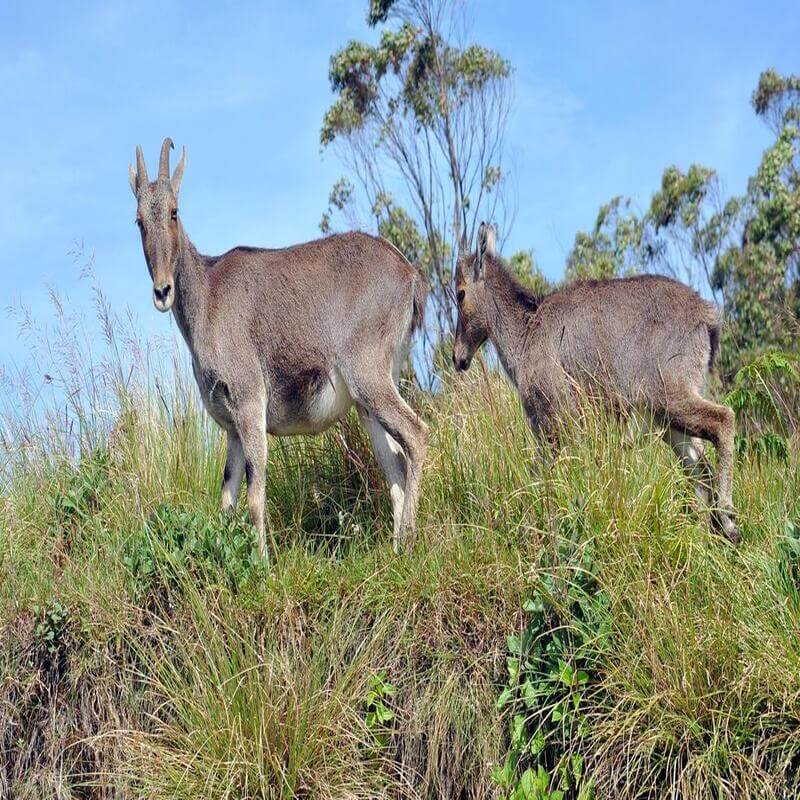
A joint census in Kerala and Tamil Nadu has reported a population of 2,668 Nilgiri tahrs. According to Forest department officials, 1,365 tahrs belong to Kerala and 1,303 to Tamil Nadu. The Eravikulam National Park (ENP) is home to the largest contiguous population of Nilgiri tahr in Kerala, numbering 841. Read here to learn more about the ungulates of India.
The Nilgiri Tahr (Nilgiritragus hylocrius), an endemic and endangered caprid, serves as a flagship species for montane grassland conservation.
Montane grasslands are high-altitude ecosystems found above 1,200 metres in the Western Ghats, often interspersed with shola forests.
Despite their ecological richness, these habitats have historically been misclassified as ‘wastelands’ and subjected to afforestation with exotic species, causing habitat loss.
Nilgiri Tahr

A joint census by Kerala and Tamil Nadu (2025) recorded 2,668 individuals:
- Kerala: 1,365 (majority in Eravikulam National Park)
- Tamil Nadu: 1,303 (including Palani Hills, Meghamalai, and Agasthiyar Ranges)
Species Overview:
- Common Names: Varayaadu, Nilgiri Ibex
- Taxonomy: The only species in the genus Nilgiritragus
- Endemic to: Southern Western Ghats of Tamil Nadu and Kerala
- Habitat:
- Montane grasslands and shola forests
- Altitude range: 1,200 to 2,600 metres
- Prefers steep cliffs, rocky terrain, and grassy slopes
Ecology and Behaviour:
- Lifespan: ~3–3.5 years in the wild (can live up to 9 years)
- Activity: Diurnal (active during the day)
- Ecological Role:
- Prey for leopards and tigers
- Indicator species for montane ecosystem health
- Coexists with other endemic fauna like Nilgiri langur and lion-tailed macaque
Threats:
- Habitat loss and fragmentation due to:
- Hydroelectric projects
- Forest clearance and tourism
- Invasive species and monoculture plantations
- Livestock competition and disease transmission
- Poaching and local extinction (e.g., in Karnataka highlands)
Conservation Status:
Parameter |
Status |
IUCN Red List |
Endangered |
WPA, 1972 |
Schedule I |
State Animal |
Tamil Nadu |
Conservation Efforts:
- Nilgiri Tahr Project by Tamil Nadu government
- Habitat restoration in grasslands and removal of invasive species
- Community involvement and eco-tourism models in areas like Eravikulam
Facts about Nilgiri Tahr
- Nilgiri Tahr is the only mountain ungulate endemic to the Western Ghats.
- Found only in India (not in Sri Lanka despite ecological similarities).
- Eravikulam National Park is home to the largest single population.
Ungulates of India
The ungulates, also known as the hoofed animals, have their class distinction due to the shape of their toe.
The Cattle, sheep, goats, deer and pigs are one family (Artiodactyla) and horses, rhino’s and tapirs are part of another family (Perissodactyla).
Perissodactyla (Odd-Toed Ungulates)
These have an odd number of toes (usually 1 or 3), and bear most of their weight on the central toe.
Species |
Scientific Name |
Conservation Status |
Rhinoceros unicornis |
Vulnerable (IUCN), Schedule I WPA |
|
Indian Wild Ass |
Equus hemionus khur |
Near Threatened, Schedule I |
Himalayan Wild Ass (Kiang) |
Equus kiang |
Least Concern (globally), rare in India |
Artiodactyla (Even-Toed Ungulates)
They have an even number of toes (usually 2 or 4) and include deer, antelopes, bovines, pigs, and giraffes (not native to India).
Deer Family (Cervidae)
Species |
Scientific Name |
Conservation Status |
Sambar Deer |
Rusa unicolor |
Vulnerable |
Chital (Spotted Deer) |
Axis axis |
Least Concern |
Barasingha (Swamp Deer) |
Rucervus duvaucelii |
Vulnerable |
Hangul (Kashmir Stag) |
Cervus hanglu hanglu |
Critically Endangered |
Indian Muntjac (Barking Deer) |
Muntiacus muntjak |
Least Concern |
Mouse Deer (Chevrotain) |
Moschiola indica |
Least Concern |
Antelope and Gazelle Family (Bovidae)
Species |
Scientific Name |
Conservation Status |
Nilgai (Blue Bull) |
Boselaphus tragocamelus |
Least Concern |
Blackbuck |
Antilope cervicapra |
Least Concern (Schedule I) |
Chinkara (Indian Gazelle) |
Gazella bennettii |
Least Concern |
Tibetan Gazelle |
Procapra picticaudata |
Near Threatened |
Himalayan Goral |
Naemorhedus goral |
Near Threatened |
Takin |
Budorcas taxicolor |
Vulnerable |
Wild Bovines (Cattle and Buffaloes)
Species |
Scientific Name |
Conservation Status |
Wild Water Buffalo |
Bubalus arnee |
Endangered |
Asiatic Wild Yak |
Bos mutus |
Vulnerable |
Gaur (Indian Bison) |
Bos gaurus |
Vulnerable (Schedule I) |
Mithun (Gayal, semi-domesticated) |
Bos frontalis |
Domesticated/ Vulnerable (wild) |
Domestic Buffalo (wild ancestors extinct) |
Bubalus bubalis |
Domesticated |
Flagship and endemic ungulates of India
Species |
Remarks |
Nilgiri Tahr |
Endemic to Western Ghats; State Animal of TN |
Hangul |
Endemic to Kashmir Valley (Dachigam NP) |
Pygmy Hog (Porcula salvinia) |
Endemic to Assam’s grasslands (Endangered) |
Wild Water Buffalo |
Found mainly in Assam and Chhattisgarh |
Conclusion
India hosts a rich diversity of ungulates adapted to varied ecosystems, from grasslands and forests to alpine regions and deserts.
Their conservation is crucial not only for biodiversity and ecosystem stability, but also for the livelihoods and cultural heritage of local communities.
Montane grasslands, though limited in area, are biodiversity hotspots critical for ecosystem services and endemic fauna.
Conservation of the Nilgiri Tahr not only protects a charismatic species but also draws attention to the urgent need for preserving India’s high-altitude grasslands.
Practice Question for Mains
Q. Montane grasslands of the Western Ghats are vital yet neglected ecosystems. Discuss the ecological significance of these habitats and the threats they face. Illustrate your answer with the case study of the Nilgiri Tahr. (250 words)
Related articles:







Leave a Reply